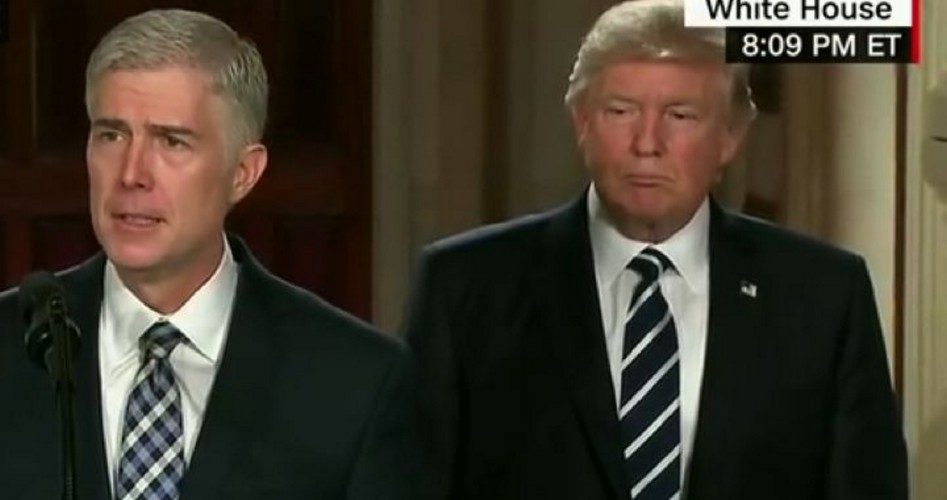
The Senate Judiciary Committee began holding hearings on March 20 to consider the nomination of Neil M. Gorsuch (shown on left) to be an associate justice of the Supreme Court, thereby filling the vacancy that has existed since the death of the late Justice Antonin Scalia, who died in February 2016. President Trump announced the nomination of Gorsuch as his pick to replace Scalia on January 31.
Gorsuch has been a federal appellate judge on the United States Court of Appeals for the Tenth Circuit. He was nominated to that position by former President George W. Bush on May 10, 2006, and was confirmed by voice vote by the Senate on July 20, 2006.
Gorsuch has such impressive credentials, including graduating from Harvard Law School cum laude with a Juris Doctor degree (where he was a classmate of former President Obama) and receiving a Doctor of Philosophy degree in Law from University College, Oxford, and subsequently clerking for U.S. Supreme Court Justices Byron White and Anthony Kennedy, that even the left-leaning American Bar Association (ABA) on March 9 gave him a “well qualified” rating to serve as a justice on the U.S. Supreme Court.
These apparent qualifications have not deterred Democrats in the Senate from attempting to make Gorsuch’s path to the High Court a rocky one, however, as became plain from the beginning of the nomination hearings.
The New York Times, long regarded as not only one of the most influential newspapers in the country, but as a leading advocate for establishment liberalism, began its coverage of the confirmation hearings by observing that they had “opened with a starkly partisan tenor. One might think it was about the man who might have been: Judge Merrick B. Garland, rather than the nominee.”
Garland, the chief judge of the United States Court of Appeals for the District of Columbia Circuit, was nominated by former president Obama a year ago to fill the vacancy created by Scalia’s death. However, the Republican-controlled Senate refused to hold a hearing or vote on this nomination so close to the end of Obama’s presidency, insisting that the next elected president should fill the vacancy. Given that most opinion polls indicated that Hillary Clinton would win the presidential election, the decision made by the Senate majority was not an obvious advantage for Republicans, but a deferred decision allowing the next Supreme Court justice to be nominated by whomever the American voters elected to the White House and therefore, a way to allow the will of the people to be accomplished.
Democrats in Congress, however, did not see it that way and resolved to block any nominee that Trump chose.
The Times report on March 20 noted:
By nominating a plainly qualified judge, Mr. Trump has forced Democrats to reckon with the kind of obstructionism they long condemned from Republicans. While several members have already said they would vote against Judge Gorsuch, the prospect of an institution-rattling fight has concerned some more moderate Democrats, particularly those who face re-election in states that Mr. Trump won.
In summarizing some highlights of the hearings, the Times observed that three Democratic senators began their opening statements with a focus on Garland.
Among these was Dianne Feinstein of California, the ranking member of the committee, who began her testimony: “We’re here today under very unusual circumstances. Merrick Garland was widely regarded as a mainstream moderate nominee.”
As Feinstein sees things, the committee’s task was now “to determine whether Judge Gorsuch is a reasonable mainstream conservative, or is he not?”
A report in the Washington Post quoted Senator Patrick J. Leahy (D-Vt.), who also harkened back to last year’s decision by Senate Republicans not to consider the nomination of Garland. Leahy described that decision as “an extraordinarily blockade” and “one of the greatest stains on the 200-year history of this committee.” He noted that the judiciary committee had once defied President Franklin D. Roosevelt’s attempts to pack the Supreme Court with more Democratic appointments.
“Now, Republicans are guilty of their own court-unpacking scheme in that their blocking of Merrick Garland was never grounded in principle or precedent,” Leahy added.
While only a majority of votes is needed to approve Gorsuch’s appointment to the court, if Democrats decide to mount a filibuster, Republicans will need to find eight Democrats to join them to secure the 60 votes necessary to invoke cloture — as the rule requiring debate to come to an end is called. Short of gaining the 60 votes needed to end the filibuster, the Republican leader can also use what is called the “nuclear option,” whereby the presiding officer of the Senate rules that the matter will be decided by a majority vote.
When he was asked by Fox News’ Sean Hannity in January about whether he would support Senate Republicans abolishing the filibuster if the Senate doesn’t reach the 60-vote supermajority needed to end a filibuster and secure a vote to confirm his Supreme Court pick, President Trump responded in the affirmative.
“Would you want [Senate Majority Leader] Mitch McConnell to use the nuclear option?” Hannity asked.
“Yes, I would,” Trump responded, citing “obstructionists” in the Senate and their delay of confirming his attorney general nominee Jeff Sessions.
The Post reported that on March 21 and 22, Gorsuch will face at least 50 minutes of questioning by each member of the committee. The proceedings are expected to conclude on the March 23 with a panel of witnesses speaking for or against Gorsuch.
Related articles:
Trump’s Supreme Court Pick Neil Gorsuch: An “Originalist”



